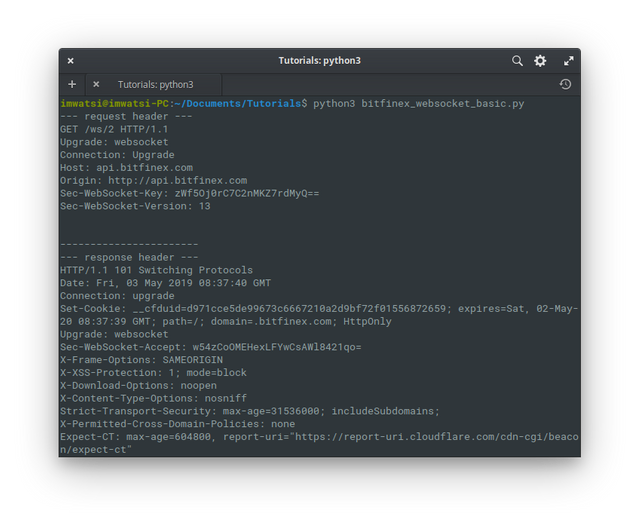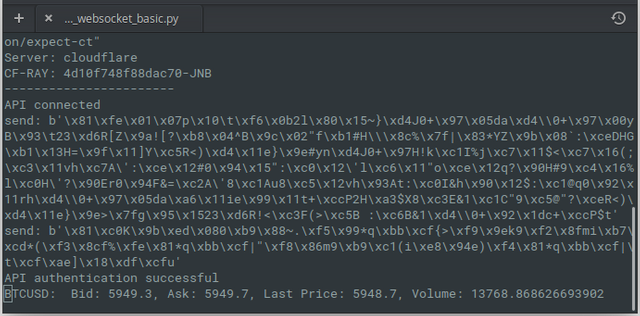Websocket Trading on Bitfinex Using Python: Part 1 - Create a Basic Authenticated Connection
Repository With Sample Code
https://github.com/imwatsi/crypto-market-samples
Find the Python script on GitHub: bitfinex_websocket_basic.py
My Profile On GitHub
You can find code used in this tutorial as well as other tools and examples in the GitHub repositories under my profile:
What Will I Learn
- Benefits of using websocket connections to trade
- Using the websocket-client module to create a websocket connection to Bitfinex's API
- Authenticating the connection
- Use API methods to subscribe to ticker data and maintain a state in memory
- Handling messages via websocket
- Placing basic orders via websocket
Requirements
- Python 3.6+
- External dependencies:
websocket-clientmodule
- Active internet connection
- An active Bitfinex account with API keys
Difficulty
Basic

Tutorial Content
In this tutorial, you will learn how to create a websocket connection to the Bitfinex exchange, authenticate it, subscribe to basic ticker data and place market orders. The Python module websocket-client will be used. You can find the Bitfinex API documentation here: https://docs.bitfinex.com/v2/reference
Setting up the environment
This tutorial assumes you already have Python 3.6 or later installed on your computer. To install the websocket-client module, use pip. Type one of the following commands on a terminal:
pip3 install websocket-clientif using Linuxpip install websocket-clientif using Windows/MacOS
Definition of terms
Below are definitions of terms used in trading that might be helpful if you're unfamiliar with them:
Ticker: a high level overview on the state of a market, usually showing current bid/ask prices, the last traded price, 24 hour volume, high/low for the day and daily percent change.
Market order: an order that's placed to execute immediately against the order book (buys at best ask price, and sells at best bid price).
Benefits of using websocket connections to trade
Realtime data streams
Websocket connections, since they remain alive throughout the session, deliver data updates faster than if you were to request the data via REST. This enables data to be pushed to your computer in realtime, so you can maintain an up-to-date state in memory.
Faster order placement
Placing orders via websocket has less latency compared to REST, again because of the live connection and smaller overhead of sent requests.
Quicker reaction to market changes
If your trading strategies rely on getting speedy updates on market conditions, then websocket is the way to go. For example, strategies based on order book depths (which are constantly changing) will need very low latency if they are to work as expected.
Writing the code
Once Python is setup and websocket-client is installed, we move on to the code.
Import necessary modules
The code below imports the modules that this script will depend on.
import websocket
import hashlib
import hmac
import json
import time
import os
from threading import Thread
websocketis used to open and maintain a websocket connectionhashlibandhmachandle encryption related operations for authenticating the connectionjsonhelps parse incoming JSON data and format outgoing requests as welltimeis used to create time delaysosis used to trigger termination of the script, when the websocket connection closesthreadingis used to create new threads for synchronous operations
Define variables and constants
# INPUT API CREDENTIALS:
API_KEY = ''
API_SECRET = ''
# GLOBAL VARIABLES
channels = {0: 'Bitfinex'}
tickers = {}
- Put the API Key and Secret from your Bitfinex account in API_KEY and API_SECRET respectively.
- channels will store the channels opened by the websocket connection and tickers will store the ticker data from the market
Write the fundamental websocket functions
To maintain a websocket connection we need a number of functions serving different purposes. We can start off with this basic frame:
def on_message(ws, message):
pass
def on_error(ws, error):
pass
def on_close(ws):
pass
def on_open(ws):
pass
def connect_api():
pass
connect_api()to create a websocket instance and initiate the connectionon_open()to perform task when a connection is openon_message()to handle messages sent back by the serveron_error()to handle errorson_close()to determine what happens when the connection is closed
connect_api()
Now, to fill in the frame...
We will use this function connect_api() to create a global object called ws, to which we will assign a new websocket instance, set its parameters and link it up with the other functions so it can run properly. As a whole, the function should contain the code shown below.
def connect_api():
global ws
websocket.enableTrace(False)
ws = websocket.WebSocketApp('wss://api.bitfinex.com/ws/2',
on_message = on_message,
on_error = on_error,
on_close = on_close,
on_open = on_open)
ws.run_forever()
- The line
websocket.enableTrace(False)disables debugging output. Set this to True to see print outputs of the connection process when trying to fix bugs. - A websocket instance (with the server address parameter) is created with
ws = websocket.WebSocketApp("wss://api.bitfinex.com/ws/2",and our other functions are linked to their appropriate parameters (on_message...etc). ws.run_forever()starts the connection
on_open()
Once a connection is opened, the function on_open is called. This is a good place to print out a statement saying the connection was opened successfully. It's also where we will handle authentication and subscription to channels (these are methods through which we receive data from the server).
The final code should look like this:
global API_KEY, API_SECRET
def authenticate():
# Authenticate connection
nonce = str(int(time.time() * 10000000))
auth_string = 'AUTH' + nonce
auth_sig = hmac.new(API_SECRET.encode(), auth_string.encode(),
hashlib.sha384).hexdigest()
payload = {'event': 'auth', 'apiKey': API_KEY, 'authSig': auth_sig,
'authPayload': auth_string, 'authNonce': nonce, 'dms': 4}
ws.send(payload)
print('API connected')
authenticate()
sub_ticker = {
'event': 'subscribe',
'channel': 'ticker',
'symbol': "tBTCUSD"
}
ws.send(json.dumps(sub_ticker))
# start printing the ticker
Thread(target=print_ticker).start()
Let's break this down. We have global declarations of API_KEY and API_SECRET, pulling in our API authentication details. There is a nested function in there: authenticate() which uses the API keys to create a signed message that will be sent to the Bitfinex server to authenticate our connection, effectively granting access to account features.
Here's an explanation of the code inside that function:
nonce = str(int(time.time() * 10000))to secure the request, Bitfinex requires "an ever increasing numeric string" as a nonce. This code creates one from the current timestamp, which will be combined with auth_string when sent.- The following code creates the signature:
auth_sig = hmac.new(API_SECRET.encode(), auth_string.encode(), hashlib.sha384).hexdigest() - With all the inputs generated, we create a dictionary and send it as JSON:
payload = {'event': 'auth', 'apiKey': API_KEY, 'authSig': auth_sig,
'authPayload': auth_string, 'authNonce': nonce, 'dms': 4}
ws.send(json.dumps(payload))
Going back to the main function on_open(), you can see that after it prints "API connected" it calls the authenticate()nested-function and then goes on to send a message with a subscription request for the BTCUSD ticker.
Finally, it starts a new thread running a function we will define later on called print_ticker, which will print the BTCUSD ticker in realtime on the terminal.
on error()
You can use this function to handle errors that occur during the websocket session. To keep things simple, I just put a print statement printing the error.
def on_error(ws, error):
print(error)
on_close()
Use this function to determine what happens when the connection closes. Here we just notify the user with a print statement and then terminate the script, to keep things simple.
def on_close(ws):
print("### API connection closed ###")
os._exit(0)
on_message()
As soon as the websocket connection is opened, messages can be sent and received. In this script, the first message that has to be received will be one notifying us of authentication status (successful or failed), from the authentication request we sent to the server.
We need code to handle this and determine whether or not it was successful. This function will also receive messages containing details of the data channels we subscribe to, as well as the data that those channels will provide. Everything will be handled by this function. The entire function's code is shown further below. Here, I will break down it's components.
global channels, tickers
data = json.loads(message)
# Handle events
if 'event' in data:
if data['event'] == 'info':
pass # ignore info messages
elif data['event'] == 'auth':
if data['status'] == 'OK':
print('API authentication successful')
else:
print(data['status'])
# Capture all subscribed channels
elif data['event'] == 'subscribed':
if data['channel'] == 'ticker':
channels[data['chanId']] = [data['channel'], data['pair']]
The code above declares the global variables channels and tickers that we defined above. A combination of if statements filter out successful authentication scenarios and capture the channels that will have been successfully subscribed to and saves them to the channels variable.
The next block of code handles the data that we receive from open channels:
# Handle channel data
else:
chan_id = data[0]
if chan_id in channels:
if 'ticker' in channels[chan_id]: # if channel is for ticker
if data[1] == 'hb':
pass
else:
# parse ticker and save to memory
sym = channels[chan_id][1]
ticker_raw = data[1]
ticker_parsed = {
'bid': ticker_raw[0],
'ask': ticker_raw[2],
'last_price': ticker_raw[6],
'volume': ticker_raw[7],
}
tickers[sym] = ticker_parsed
Channels are identified by channel ID numbers and these are the keys used to store entries in the channels dictionary. The code above extracts the channel ID from the message and looks for a match in the stored channels.
If one is found, a further check is made to make sure the channel is for a ticker with the line if 'ticker' in channels[chan_id]:. This filters out other channel types, when you have order book and candle data channels for example.
Bitfinex sends heartbeat messages at regular intervals to keep a channel open, so we ignore these with:
if data[1] == 'hb':
pass
The rest of the code parses the ticker information and saves it to the tickers variable. Bitfinex sends these updates as sets of lists, so bid, ask , etc will be indexed; hence the ticker_raw[0] references.
These messages will be coming in frequently and when you have multiple tickers subscribed (100 market symbols for example) the function on_message will be used each time, which can be multiple times per fraction of a second. In this case, this can be a latency bottleneck and measures will need to be taken to reduce the amount of computations done in this function by deferring them to other functions and opening new threads. My next tutorial will be on this subject.
To wrap up the on_message function: it should look like this in its entirety:
def on_message(ws, message):
global channels, balances, tickers
data = json.loads(message)
# Handle events
if 'event' in message:
if data['event'] == 'info':
pass # ignore info messages
elif data['event'] == 'auth':
if data['status'] == 'OK':
print('API authentication successful')
else:
print(data['status'])
# Capture all subscribed channels
elif data['event'] == 'subscribed':
if data['channel'] == 'ticker':
channels[data['chanId']] = [data['channel'], data['pair']]
# Handle channel data
else:
chan_id = data[0]
if chan_id in channels:
if 'ticker' in channels[chan_id]: # if channel is for ticker
if data[1] == 'hb':
pass
else:
# parse ticker and save to memory
sym = channels[chan_id][1]
ticker_raw = data[1]
ticker_parsed = {
'bid': ticker_raw[0],
'ask': ticker_raw[2],
'last_price': ticker_raw[6],
'volume': ticker_raw[7],
}
tickers[sym] = ticker_parsed
new_order_market()
Next, we define a new function with which new market orders can be placed. It starts by declaring global variable ws (the websocket instance). Then it generates a "client order ID" for the new order using a timestamp.
After that, it creates a dictionary containing the order's details: the client order ID, trade symbol(e.g. BTCUSD) and the amount being transacted. This dictionary is included in a special message format required by Bitfinex.
The message must be sent as a list, to the 0 (zero) channel, with the order details as payload, as seen below. Once this is compiled it will be sent as JSON via ws.send() function.
def new_order_market(symbol, amount):
global ws
cid = int(round(time.time() * 1000))
order_details = {
'cid': cid,
'type': 'EXCHANGE MARKET',
'symbol': 't' + symbol,
'amount': str(amount)
}
msg = [
0,
'on',
None,
order_details
]
ws.send(json.dumps(msg))
To use this function to place an order, you can call it with new_order_market("BTCUSD", 0.01) for example, to buy 0.01 BTC at market price. Use negative amounts to sell.
It can also be invoked from user input by adding a function like the one below and opening a new thread for it at script init. It runs a loop listening for user commands, and executing instructions as coded.
def user_input():
while True:
command = input()
if command == 'Buy':
new_order_market("BTCUSD", 0.01)
print_ticker()
The last function we will write is a loop used to retrieve the current ticker data from memory and print it on the terminal. It uses a print statement with end="\r" to maintain the print on the same line while updating the values, so you can see the ticker change in realtime.
def print_ticker():
global ticker
symbol = 'BTCUSD'
while len(tickers) == 0:
# wait for tickers to populate
time.sleep(1)
while True:
# print BTCUSD ticker every second
details = tickers[symbol]
print('%s: Bid: %s, Ask: %s, Last Price: %s, Volume: %s'\
%(symbol, details['bid'], details['ask'],\
details['last_price'], details['volume']), end="\r", flush=True)
time.sleep(1)
That's it! The script is done.
Debug output
Below are screenshots of output from setting websocket.enableTrace(True). The first screenshot contains header information for the request we sent and the response received as the connection is being established.

The next screenshot shows our print statements mixed with what seems to be gibberish. There are two send statements there: one for authenticating the connection and one for subscribing to the BTCUSD ticker channel. Both are encrypted, hence their illegible form. The last line is where the script prints out the realtime ticker, updated every second as we stated in the code.

You should get the following terminal output when you run the script normally:

Thank you for your contribution @imwatsi
After reviewing your contribution, we suggest you following points:
The structure of your tutorial has improved, but try to improve it a bit more.
Please enter comments in your code sections. As we said earlier the comments are quite useful for less experienced code readers.
It would be interesting throughout your tutorial to put more images on the results of what you are explaining.
Thank you for following some suggestions we put on your previous tutorial.
Thank you for your work in developing this tutorial.
Looking forward to your upcoming tutorials.
Your contribution has been evaluated according to Utopian policies and guidelines, as well as a predefined set of questions pertaining to the category.
To view those questions and the relevant answers related to your post, click here.
Need help? Chat with us on Discord.
[utopian-moderator]
Thanks for the review.
Thank you for your review, @portugalcoin! Keep up the good work!
Hi @imwatsi!
Your post was upvoted by @steem-ua, new Steem dApp, using UserAuthority for algorithmic post curation!
Your post is eligible for our upvote, thanks to our collaboration with @utopian-io!
Feel free to join our @steem-ua Discord server
Hey, @imwatsi!
Thanks for contributing on Utopian.
We’re already looking forward to your next contribution!
Get higher incentives and support Utopian.io!
Simply set @utopian.pay as a 5% (or higher) payout beneficiary on your contribution post (via SteemPlus or Steeditor).
Want to chat? Join us on Discord https://discord.gg/h52nFrV.
Vote for Utopian Witness!
The post is so professional to understand the whole information but it was worth anyway, thanks https://9blz.com/bitfinex-review/